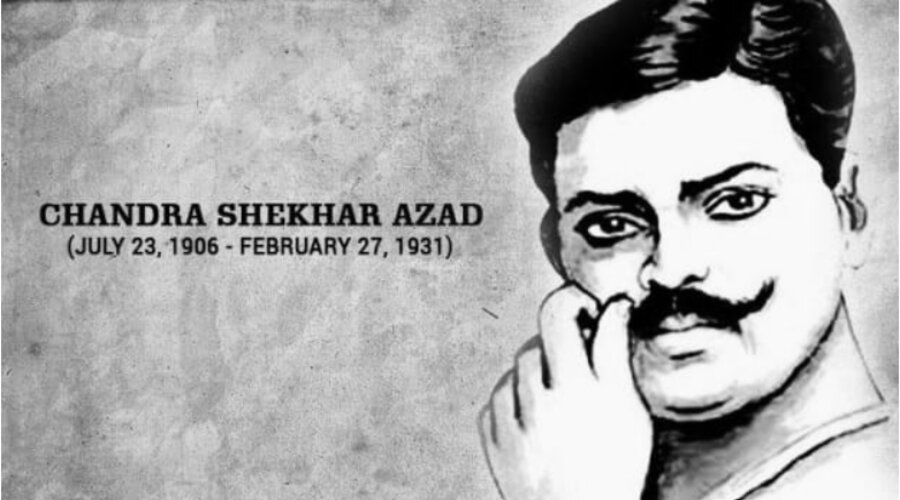Chandra Shekhar Azad, also known as Chandrashekhar Tiwari, was a legendary Indian revolutionary who played a vital role in the Indian independence movement. Born on July 23, 1906, in Bhabra, Madhya Pradesh, he is one of the most iconic figures of the Indian independence struggle. His name is synonymous with bravery, sacrifice, and patriotism. He is remembered as a fearless freedom fighter who gave his life for the cause of India’s independence.
Early Life of Chandra Shekhar Azad:
Chandra Shekhar Azad was born in a poor family in Bhabra, a small village in the present-day state of Madhya Pradesh. His father, Pandit Sitaram Tiwari, was a poor farmer, and his mother, Jagrani Devi, was a housewife. Despite financial hardships, Azad was a bright student and excelled in academics. He was interested in sports, especially wrestling and swimming.
In 1921, when Azad was just 15 years old, Mahatma Gandhi launched the Non-Cooperation Movement, which inspired him to join the freedom struggle. He actively participated in the movement and was arrested several times. It was during this time that he met his mentor, Ram Prasad Bismil, a prominent revolutionary who was also a member of the Hindustan Republican Association (HRA).
Revolutionary Activities:
In 1923, Chandra Shekhar Azad joined the Hindustan Republican Association (HRA), which was later renamed the Hindustan Socialist Republican Association (HSRA). The group was formed with the objective of overthrowing the British colonial government and establishing a democratic government in India. Azad became an active member of the group and was involved in several revolutionary activities.
One of the most significant events in which Azad played a crucial role was the Kakori train robbery in 1925. The robbery was aimed at looting the British government’s treasury, which was being transported on a train. Azad was one of the key members of the group that carried out the robbery. The incident shook the British government, and the group became the target of intense police surveillance.
After the Kakori train robbery, the HSRA members were forced to go underground. Azad continued his revolutionary activities and was involved in several shootouts with the police. He was known for his exceptional marksmanship and never missed a target. He used to practice shooting at the banks of the river Ganges, where he would throw a coin in the air and shoot it before it fell into the water.
Death:
On February 27, 1931, Chandra Shekhar Azad was surrounded by the police in Alfred Park (now renamed as Chandrashekhar Azad Park) in Allahabad. He was accompanied by two other revolutionaries, Sukhdev Raj and Rajguru. In the ensuing gun battle, Sukhdev Raj and Rajguru were captured, but Azad managed to escape. He ran towards a tree and started firing at the police. He fought valiantly and killed several policemen before he was self hit by a bullet in the forehead by Himself.
Chandra Shekhar Azad knew that he would not be captured alive by the British police, and he fulfilled his promise to himself. He had vowed to never be caught alive by the British, and he died fighting for the cause of India’s independence.
Legacy:
Chandra Shekhar Azad is remembered as a hero who sacrificed his life for the freedom of his country. He was a true patriot who dedicated his life to the cause of India’s independence. He was a role model for millions of Indians who aspired for a free society. His bravery, courage, and determination inspired a generation of young Indians to join the freedom struggle.
Today, Chandra Shekhar Azad is remembered through several monuments, parks, and memorials across India. The Chandrashekhar Azad Park in Allahabad, where he died fighting, is one of the most popular tourist attractions in the city. The park has a statue of Azad, and his favorite tree, under which he took his last breath, still stands there.
In addition to physical memorials, Chandra Shekhar Azad’s legacy is also celebrated through books, movies, and literature. Several books and biographies have been written on his life, which inspire people to fight for justice and freedom. Movies and plays based on his life have been made, which bring his story to a wider audience.
Conclusion:
Chandra Shekhar Azad was a revolutionary who lived and died for the cause of India’s independence. He was a symbol of courage and bravery, and his life is an inspiration for generations to come. He believed in the power of youth and education and always encouraged young Indians to join the freedom struggle. Even today, his message of fighting for justice and freedom resonates with people across India and the world. Chandra Shekhar Azad’s legacy will continue to inspire people to fight for a just and equitable society.
READ MORE
- शहीद भगत सिंह भारतीय युवाओं के वीरता के प्रतीक
- Maharana Pratap Singh: The Invincible Warrior महाराणा प्रताप सिंह का जीवन
- छत्रपति शिवाजी महाराज का इतिहास और जीवनी
- महात्मा गांधी के प्रयोगों में लियो टॉलस्टॉय की भूमिका
- गांधीवादी विचारधारा में भगत सिंह कहां चूकते हैं?
- Gandhi Jayanti: Non-violence Legacy
- Dr. Zakir Hussain: A Visionary President and Statesman

